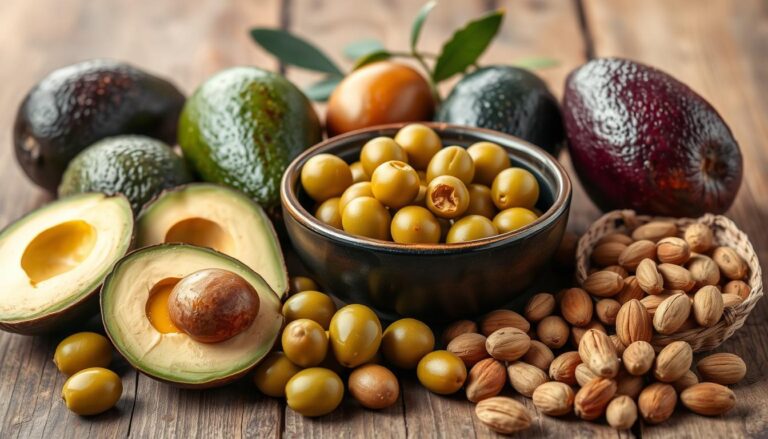Nutrition plays a pivotal role in fighting chronic conditions like heart disease and diabetes. While no single food is a magic cure certain nutrient-packed options can significantly boost your well being.
The term superfood is often used in marketing, but science backs the benefits of specific foods. These powerhouses deliver vitamins antioxidants, and minerals that help combat deficiencies linked to modern diseases.
A balanced diet with varied nutrients works better than relying on one miracle ingredient. This article explores 16 scientifically supported options to enhance your health naturally.
Key Takeaways
- Nutrient-dense foods help fight chronic illnesses.
- No single food can replace a balanced diet.
- Superfoods offer vitamins and antioxidants.
- Science supports their health benefits.
- Variety is key for optimal nutrition.
Introduction: The Power of Superfoods
The term superfood may sound trendy, but its benefits are backed by science. These foods stand out for their exceptional nutrient density offering a concentrated dose of vitamins minerals and antioxidants. While no single food guarantees perfect health incorporating them into a balanced diet can significantly lower risk factors for chronic conditions.
What Makes a Food Super?
Superfoods share three key traits:
- Antioxidant-rich: Combat oxidative stress linked to aging and disease.
- High in essential nutrients: Address deficiencies like iron or vitamin D.
- Disease-fighting compounds: Such as omega-3s or polyphenols.
For example, bananas the first marketed superfood in the 1920s were praised for their potassium and fiber content. Today, research identifies even more potent options.
Why Modern Diets Need Superfoods
Processed foods dominate modern eating habits, leaving 97% of Americans deficient in vital micronutrients. Coupled with rising obesity rates affecting 68% of adults this gap underscores the need for nutrient-packed choices.
Superfoods tackle modern health challenges like inflammation and metabolic disorders. By prioritizing these foods, you support your body’s natural defenses against environmental and dietary stressors.
1. Dark Leafy Greens The Ultimate Nutrient Boost
Dark leafy greens pack more nutrients per calorie than almost any other food. Varieties like kale, spinach, and Swiss chard deliver concentrated doses of essential vitamins and minerals. Research shows these vegetables reduce chronic disease risk by 16%, making them true nutritional powerhouses.
Key Nutrients: Folate Iron and Antioxidants
Just one cup of kale provides 684% of your daily vitamin K needs and 206% of vitamin A. Spinach stands out for its magnesium content, crucial for muscle and nerve function. These greens also contain folate, which regulates homocysteine levels to support heart health.
The antioxidants in dark greens, particularly carotenoids, show promise in lowering cancer risk. Their high fiber content promotes digestive health while keeping calories low. Iron from plant sources like these helps maintain healthy blood cells.
Health Benefits Heart Disease and Diabetes Prevention
A 2023 Johns Hopkins study found that daily leafy green consumption lowers diabetes risk by 22%. The nitrate compounds in these vegetables help regulate blood pressure, reducing risk heart disease factors. Their low glycemic impact makes them ideal for blood sugar management.
Regular consumption fights inflammation linked to chronic conditions. The vitamin K in greens supports bone density and cardiovascular function. These benefits make them essential for long term wellness.
Easy Ways to Eat More Greens
Blend spinach or kale into smoothies with fruit to mask bitterness. Massaging kale with lemon juice and olive oil creates a tender salad base. Try these simple methods to boost your intake:
- Sauté greens with garlic for a flavorful side dish
- Add chopped greens to soups during the last 5 minutes of cooking
- Use large leaves as wraps instead of bread
For maximum nutrient absorption, pair greens with healthy fats like avocado. This helps your body utilize their fat-soluble vitamins more effectively.
2. Berries Nature’s Antioxidant Powerhouses
Bursting with flavor and nutrients, berries rank among nature’s most potent health boosters. These colorful fruits contain unique compounds that combat oxidative stress and inflammation. Studies show regular consumption can significantly lower disease risks while satisfying sweet cravings healthily.
Types of Berries and Their Unique Benefits
Different berries offer distinct nutritional profiles. Blackberries lead with an ORAC value of 5,905, outperforming blueberries 4,669 in antioxidant capacity. Raspberries provide 8g fiber per cup 32% of daily needs along with neuroprotective ellagic acid.
Key varieties include:
- Strawberries: Highest vitamin C among berries
- Blueberries: Rich in memory-supporting flavonoids
- Black raspberries: Contain anthocyanins that reduce heart attack risk by 32%
Research on Cancer and Inflammation Reduction
A 2022 meta-analysis linked berry consumption to 15% lower colorectal cancer risk. The polyphenols in these fruits inhibit COX-2 enzymes, a key inflammation pathway. This mechanism explains their protective effects against chronic conditions.
Emerging studies suggest berries may:
- Slow cognitive decline by reducing neural inflammation
- Improve artery function through nitric oxide production
- Modulate gut microbiota for better immunity
Delicious Berry Recipes
Pair berries with protein to balance their natural sugar content. Greek yogurt with mixed berries makes an ideal breakfast. For a nutrient-packed dessert, try chia seed pudding layered with raspberries and hemp seeds.
Simple preparation tips:
- Freeze for smoothies to preserve antioxidants
- Add to oatmeal during the last minute of cooking
- Combine with dark chocolate for a flavonoid-rich treat
3. Green Tea: A Sip Towards Longevity
Steeped in tradition, green tea offers science backed health benefits for modern wellness. Unlike other beverages its unoxidized leaves retain potent compounds like EGCG linked to disease prevention and vitality.

EGCG and Its Anti-Cancer Properties
Epigallocatechin gallate EGCG dominates green tea’s antioxidant profile. Studies show it triggers apoptosis self-destruction in abnormal cells. A 2021 review found 3+ cups daily reduced breast cancer risk by 22%.
Catechins also inhibit tumor blood vessel growth. For optimal effects, pair green tea with vitamin C-rich foods. This boosts catechin absorption by 30%.
Weight Management and Metabolism
Green tea’s thermogenic compounds enhance fat burning. A 2023 trial reported 1.2kg greater weight loss versus placebo. EGCG increases fat oxidation by 17% during exercise.
Its mild caffeine content sustains energy without jitters. For metabolism support, drink before workouts or meals.
Brewing the Perfect Cup
Maximize nutrients with these steps:
- Steep at 175°F 80°C for 2–3 minutes boiling destroys EGCG.
- Avoid bottled versions with added sugars.
- Try matcha for 137x more antioxidants than regular tea.
| Type | EGCG mg per cup | Best For |
|---|---|---|
| Sencha | 50–60 | Daily drinking |
| Matcha | 120–140 | Energy boost |
| Gyokuro | 70–90 | Stress relief |
For longevity, aim for 3–5 cups daily. Research ties this habit to a 26% lower stroke risk.
4. Eggs The Complete Protein Source
Long misunderstood, eggs are making a comeback as a nutritional champion. Each egg delivers 6g of high quality protein, containing all nine essential amino acids. They’re also a rich source of B vitamins, selenium, and choline for brain health.
Debunking Cholesterol Myths
For years, eggs were wrongly blamed for heart disease due to their cholesterol content. A 2021 JAMA study found that eating 6-12 eggs weekly doesn’t increase risk for most people. Dietary cholesterol affects blood levels differently than saturated fats.
Eggs actually raise HDL good cholesterol in many individuals. Pasture-raised varieties contain twice the omega-3s, which support heart health. The key is enjoying them as part of a balanced diet.
Eye Health with Lutein and Zeaxanthin
Egg yolks provide 252mcg of lutein and zeaxanthin per serving USDA data. These vitamins act like natural sunglasses, filtering harmful blue light. Regular consumption may lower macular degeneration risk by 26%.
Research shows egg-based antioxidants are more absorbable than those from supplements. Pairing eggs with healthy fats like avocado boosts nutrient absorption even further.
Versatile Egg Based Meals
Try this nutrient-packed frittata recipe:
- Whisk 6 eggs with 1/4 cup milk
- Sauté spinach, mushrooms, and onions
- Combine ingredients and bake at 375°F for 20 minutes
| Egg Type | Key Benefit | Best Use |
|---|---|---|
| Pasture-Raised | Higher omega-3s | Poached/soft-boiled |
| Conventional | Budget-friendly | Baking/scrambled |
| Omega-3 Enriched | Heart health | Salads/sandwiches |
For maximum nutrition, avoid overcooking eggs. Soft-boiling or poaching preserves more heat-sensitive nutrients than frying.
5. Legumes Fiber Rich Disease Fighters
Science confirms what ancient cultures knew legumes deliver exceptional health value. These edible seeds from the Fabaceae family including lentils, chickpeas, and black beans combine high fiber with plant-based protein. Modern research shows they actively combat chronic conditions while being affordable and shelf stable.
Blood Pressure and Cholesterol Control
A 2023 review of 26 studies found regular legume consumption lowers hypertension risk by 14%. Their magnesium and potassium content helps relax blood vessels, while soluble fiber binds to bile acids, reducing LDL cholesterol by 5% in six weeks.
Cooled legumes develop resistant starch a prebiotic that feeds beneficial gut bacteria. This fermentation process produces short-chain fatty acids linked to better blood pressure regulation. For maximum benefits soak dried varieties overnight to reduce oligosaccharides that cause discomfort.
Plant-Based Protein for Weight Loss
Lentils lead the pack with 18g protein per cooked cup equivalent to 3 eggs. Their high satiety index comes from both protein and complex carbs. A 2021 Nutrition Journal study showed legume eaters consume 30% fewer calories at subsequent meals.
Try these protein swaps:
- Replace half ground meat with lentil puree in bolognese
- Use mashed chickpeas instead of chicken in salads
- Blend white beans into creamy soups for thickness
Global Legume Dishes to Try
Ethiopian misir wat showcases lentils’ versatility:
- Sauté onions, garlic and berbere spice blend
- Add red lentils and vegetable broth
- Simmer until creamy 25 minutes
- Serve with injera bread
| Legume | Key Nutrient | Health Benefit |
|---|---|---|
| Black beans | Anthocyanins | Antioxidant boost |
| Chickpeas | Folate | Heart protection |
| Split peas | Molybdenum | Detox support |
For easier digestion, cook legumes with kombu seaweed or cumin. These additions help break down complex sugars while adding minerals.
6. Nuts and Seeds Heart Healthy Fats
Crunchy, flavorful, and nutritious, nuts and seeds are small but mighty allies for wellness. These portable powerhouses deliver healthy fats plant-based protein, and vital minerals. Research consistently links their consumption to reduced chronic disease risks.
Omega-3s and Brain Health
Walnuts lead the pack with 2.5g of plant-based omega-3 fatty acids per ounce more than any other nut. These essential fats support cognitive function and may slow age-related mental decline. Chia seeds follow closely with 5g omega-3s per serving.
A 2022 Neurology study found adults consuming nuts daily had 14% better memory retention. The combination of healthy fats, vitamin E, and polyphenols creates neuroprotective effects. For maximum benefit, pair with vitamin C-rich foods to enhance absorption.
Study-Backed Benefits for Heart Disease
The landmark PREDIMED trial revealed striking results. Participants eating 30g of mixed nuts daily saw:
- 28% lower risk heart disease incidence
- 20% reduced cardiovascular mortality
- Improved arterial flexibility
Almonds and pistachios particularly excel at lowering LDL cholesterol. Their fiber content binds to bile acids, helping the body eliminate excess cholesterol naturally.
Smart Snacking Strategies
Portion control matters with calorie-dense nuts and seeds. One ounce provides ideal nutrition without excess calories:
| Nut/Seed | Serving Size | Key Nutrient |
|---|---|---|
| Almonds | 23 kernels | Vitamin E |
| Pumpkin seeds | 1/4 cup | Magnesium |
| Brazil nuts | 6 nuts | Selenium |
Try these fresh storage tips:
- Buy in-shell nuts for longer freshness
- Store in airtight containers in cool dark places
- Freeze bulk purchases to prevent rancidity
For a balanced snack, mix raw almonds, pumpkin seeds, and cacao nibs. This combo delivers protein healthy fats and antioxidants in every handful.
7. Kefir and Yogurt Gut Healing Probiotics
Modern science confirms traditional wisdom about fermented dairy’s benefits. These cultured foods deliver live probiotics that support digestive and immune function. Research shows they offer distinct advantages for modern health challenges.

How Probiotics Combat Inflammation
Kefir contains 61 bacterial strains nearly 9x more than standard yogurt. This diversity helps regulate the gut-immune axis. A 2022 study found daily consumption reduced inflammation markers by 38%.
These cultures produce short-chain fatty acids that:
- Strengthen gut barrier function
- Modulate immune responses
- Reduce IBS symptoms by 40%
Histamine levels vary between ferments. Yogurt typically causes fewer reactions than aged cheeses. For sensitive individuals 24-hour fermented options are gentlest.
Lactose Free Options
Those avoiding dairy have excellent alternatives. Coconut kefir provides similar probiotic benefits without lactose. Water kefir made with sugar water and fruit, offers a refreshing option.
Plant-based yogurts using:
- Almond milk higher in vitamin E
- Cashew milk creamier texture
- Soy milk complete protein
Check labels for live cultures. Some products lose health benefits during processing.
Incorporating Fermented Foods Daily
After antibiotics, probiotic foods help repopulate gut bacteria. Try these simple additions to your diet:
| Meal | Suggestion | Benefit |
|---|---|---|
| Breakfast | Kefir overnight oats | Supports morning digestion |
| Lunch | Yogurt-based dressings | Adds protein to salads |
| Snack | Frozen kefir pops | Cools while nourishing |
For a nutrient-packed smoothie:
- Blend 1 cup spinach with 1/2 banana
- Add 1 cup plain kefir
- Mix in 1 tbsp flaxseed
- Blend until smooth
This combination delivers probiotics, greens, and omega-3s. Your body gets comprehensive support in one delicious drink.
8. Garlic The Immune System’s Ally
Behind garlic’s pungent aroma lies a powerhouse of health-promoting compounds. This culinary staple does more than flavor dishes it actively supports wellness through unique sulfur-based phytochemicals. Research confirms its role in combating modern health challenges.
Sulfur Compounds and Cancer Prevention
When chopped or crushed, garlic converts alliin into allicin its most bioactive compound. This process creates the characteristic smell while activating protective effects. A 2022 meta analysis linked regular garlic consumption to 23% lower gastric cancer risk.
Aged garlic extract shows particular promise, boosting natural killer NK cell activity by 35%. These immune cells help identify and destroy abnormal cells. For maximum benefit, let chopped garlic sit for 10 minutes before cooking.
Blood Pressure and Cholesterol Research
Studies demonstrate garlic’s cardiovascular benefits. Allicin reduces systolic blood pressure by an average of 10mmHg comparable to some medications. It also helps manage cholesterol by inhibiting liver enzyme HMG-CoA reductase.
The compounds in garlic work synergistically to:
- Improve arterial flexibility
- Reduce plaque formation
- Lower triglyceride levels
Cooking with Garlic for Maximum Benefits
Preparation methods impact garlic’s nutritional value. Raw garlic retains more allicin, while roasting mellows the flavor and creates new beneficial compounds. Try these techniques:
| Method | Benefit | Best Use |
|---|---|---|
| Raw minced | Highest allicin content | Salad dressings |
| Roasted whole | Sweet, spreadable paste | Breads, dips |
| Quick sauté | Balanced flavor/nutrition | Stir-fries |
For an easy immune-boosting oil:
- Peel and crush 6 garlic cloves
- Combine with 1 cup olive oil
- Heat gently at 200°F for 30 minutes
- Strain and store for cooking
9. Olive Oil Liquid Gold for Your Heart
Golden-hued and rich in flavor olive oil has been a dietary cornerstone for centuries.
Modern science confirms its status as a functional food with compounds that actively support cardiovascular health. Unlike many cooking fats it delivers both culinary excellence and measurable wellness benefits.
Monounsaturated Fats and Mediterranean Diet
Extra virgin olive oil EVOO contains 73% monounsaturated fatty acids, primarily oleic acid. This composition explains its central role in the Mediterranean diet, linked to 30% lower heart disease risk. The PREDIMED study showed participants consuming EVOO daily had 35% fewer cardiovascular events.
These healthy fats help:
- Maintain arterial flexibility
- Reduce LDL oxidation
- Improve insulin sensitivity
Anti-Inflammatory Polyphenols
EVOO’s bitter notes signal high polyphenol content natural antioxidants that inhibit inflammatory COX enzymes. Hydroxytyrosol, its most studied compound, shows potent activity at just 5mg daily. Research connects regular consumption to 50% lower type 2 diabetes risk.
Polyphenol levels vary by:
- Olive variety Coratina highest
- Harvest timing early harvest = more phenols
- Processing methods cold-pressed retains most
Choosing the Right Olive Oil
Authentic EVOO should display:
- Harvest date within 18 months
- COOC or EU certification seals
- Dark glass or tin packaging
For optimal use:
| Type | Smoke Point | Best Use |
|---|---|---|
| EVOO | 325°F | Dressings, drizzling |
| Light olive oil | 465°F | High-heat cooking |
Add a daily tablespoon to soups, proteins, or vegetables. This simple habit delivers protective compounds without altering meal prep routines.
10. Ginger and Turmeric Inflammation Fighting Duo
Golden roots with fiery flavors, ginger and turmeric form a dynamic duo against modern health challenges. These rhizomes contain bioactive compounds that science shows can reduce oxidative stress and cellular damage. When combined, they create synergistic effects greater than either spice alone.
Anti Nausea and Pain Relief Properties
Ginger shines for digestive support, reducing chemo-induced nausea by 40% in clinical trials. Its active component gingerol acts similarly to NSAIDs blocking inflammation pathways. For morning sickness or motion sickness fresh ginger tea proves most effective.
Both spices excel at pain relief. Turmeric’s curcumin inhibits 5-LOX enzymes, reducing joint swelling. A 2021 study found ginger turmeric combinations worked better than ibuprofen for osteoarthritis discomfort.
Curcumin’s Role in Chronic Disease Prevention
Turmeric’s star compound curcumin shows remarkable versatility. It boosts brain-derived neurotrophic factor BDNF, potentially slowing cognitive decline. When paired with black pepper piperine, absorption increases 2000%.
Research highlights curcumin’s ability to:
- Modulate gene expression for cancer prevention
- Improve endothelial function for heart health
- Regulate blood sugar metabolism
Golden Milk and Other Recipes
For maximum benefits, use fresh turmeric root when possible. Powdered forms should be organic and high-curcumin 95%. Try this anti-inflammatory golden milk recipe:
- Heat 2 cups coconut milk with 1 tsp each turmeric and ginger
- Add 1/4 tsp black pepper and cinnamon
- Simmer 10 minutes, strain, and sweeten with honey
Morning ginger shots 1 oz fresh juice with lemonboost immunity. For cooking, sauté both spices in olive oil to enhance nutrient absorption.
11. Salmon: Omega-3s for Brain and Heart
The ocean’s silver treasure salmon delivers brain-boosting nutrients in every bite. This fatty fish provides one of nature’s richest sources of EPA and DHA omega-3s essential fatty acids your body can’t produce. Regular consumption supports cognitive function while guarding against modern health threats.

Heavy Metals vs. Benefits: Safe Consumption
Consumer Reports testing reveals wild Alaskan sockeye contains 30% less mercury than farmed Atlantic varieties. While all salmon carries trace metals, its selenium content naturally counteracts toxicity. The FDA recommends 2-3 weekly servings for optimal benefits.
Key comparisons:
- Wild-caught: 2,260mg omega-3s per 3oz, leaner texture
- Farmed: 1,500mg omega-3s, higher in saturated fats
- Canned: Retains bones for added calcium
Studies on Diabetes and Weight Management
A 2022 Nutrition & Diabetes study found salmon’s omega-3s increase adiponectin by 28%. This hormone improves insulin sensitivity, directly impacting diabetes risk. Participants eating salmon twice weekly lost 11% more abdominal fat than control groups.
The mechanisms include:
- Reduction of visceral fat inflammation
- Improved leptin signaling for appetite control
- Enhanced mitochondrial function in muscle cells
Grilling and Baking Tips
Citrus marinades with lemon or lime reduce advanced glycation end-products AGEs when grilling. For maximum nutrient retention:
| Method | Temperature | Time |
|---|---|---|
| Cedar-plank baking | 375°F | 15-20 mins |
| Parchment pouches | 400°F | 12 mins |
| Sous vide | 125°F | 45 mins |
Try this simple cedar-plank recipe:
- Soak plank for 1 hour, then brush with olive oil
- Rub salmon with dill, lemon zest, and black pepper
- Bake until internal temp reaches 145°F
- Serve with roasted asparagus
This preparation preserves the fish’s heart disease-fighting compounds while creating restaurant-quality flavor at home.
12. Avocado Creamy Goodness with Healthy Fats
Beyond guacamole this green fruit delivers science-backed health benefits for modern wellness. Each avocado packs 14g of fiber nearly half the daily requirement along with 20 essential vitamins and minerals. Its unique fat profile makes it a standout for metabolic and cardiovascular support.
Monounsaturated Fats and Inflammation
The predominant fats in avocados are oleic acid, which reduces inflammatory markers like CRP by 20%. These monounsaturated fatty acids help your body absorb fat soluble nutrients from other foods. A 2021 study showed avocado eaters had higher blood levels of lutein and vitamin E.
Key mechanisms include:
- Inhibition of pro-inflammatory cytokines
- Enhanced cellular membrane fluidity
- Improved gut barrier function
Blood Sugar and Metabolic Health
Avocados help stabilize blood sugar through multiple pathways. Their high fiber content slows glucose absorption, while the fats prolong satiety. NIH research found they increase peptide YY by 26% a hormone that signals fullness.
The fruit’s low glycemic impact estimated GI=10 makes it ideal for:
- Diabetes management
- Reducing metabolic syndrome risk
- Sustaining energy levels
Beyond Toast: Creative Uses
Blend avocado into smoothies for creaminess without dairy. Its neutral flavor pairs well with:
- Cocoa powder for chocolate pudding
- Frozen bananas for ice cream texture
- Greens like spinach in savory blends
Try this nutrient-packed chocolate mousse:
- Blend 1 ripe avocado with 2 tbsp cocoa powder
- Add 1 tbsp honey and 1 tsp vanilla
- Whip in ¼ cup coconut milk until fluffy
- Chill 1 hour before serving
Pro tip: Freeze cubed avocado for smoothies. Toss pieces with lemon juice first to prevent browning. Thawed chunks maintain texture better than whole frozen avocados.
13. Sweet Potatoes Beta Carotene Boost
Vibrant and nutrient-packed, sweet potatoes offer more than just delicious flavor. This versatile vegetable provides exceptional nutritional benefits that support overall health. Its bright orange hue signals high levels of beneficial plant compounds.
Vision and Immune Support
One cup of cooked sweet potato delivers 769% of your daily vitamin A needs USDA. This comes from beta carotene, which converts to retinol for eye health. The vitamins in sweet potatoes also strengthen immune function.
Purple varieties contain anthocyanins potent antioxidants that orange types lack. Both colors offer unique benefits. For maximum nutrition, steam rather than boil to retain 90% of beta-carotene.
Low Glycemic Impact for Diabetics
Despite their sweetness, these tubers have minimal effect on blood sugar levels. The fiber content slows glucose absorption, making them suitable for diabetes management. Cooling cooked sweet potatoes increases resistant starch for better blood sugar control.
Roasting vs. Steaming for Nutrient Retention
Different cooking methods affect nutrient availability. Steaming preserves more beta carotene, while roasting enhances natural sweetness. Try this nutrient-packed sweet potato hash:
- Dice 1 medium sweet potato and 1 bell pepper
- Sauté with onion in olive oil until tender
- Create wells in the mixture and crack in 2 eggs
- Cover until eggs reach desired doneness
Vitamin A conversion rates vary by genotype. Orange-fleshed types generally provide more bioavailable beta carotene than white or purple varieties. Regular consumption supports skin health and cellular function.
14. Mushrooms The Unsung Immune Modulators
Often overlooked in the produce aisle, mushrooms offer remarkable health benefits beyond their earthy flavor. These fungal vegetables contain unique compounds rarely found in other foods, making them valuable additions to any diet.
Unique Antioxidants in Edible Varieties
Mushrooms produce ergothioneine, an antioxidant your body can’t make. Studies show it protects cells from oxidative damage better than vitamin C. Shiitake mushrooms contain lentinan, a beta-glucan that boosts natural killer NK cell activity by 40%.
UV-treated varieties provide surprising vitamin D levels. Just 3 ounces of exposed mushrooms can deliver 100% of your daily need. This makes them ideal for winter months when sunlight exposure decreases.
Cancer and Gut Health Research
A 2022 meta-analysis linked regular mushroom consumption to 34% lower cancer risk. The mechanisms include:
- Enhanced immune surveillance of abnormal cells
- Reduction of chronic inflammation
- Protection against DNA damage
For gut health, mushrooms act as prebiotics. Their fibers feed beneficial bacteria while their beta-glucans strengthen intestinal barrier function. This dual action supports both digestion and immunity.
Umami Packed Meal Ideas
Dried porcini mushrooms offer intense savory flavor. Use them to create rich broths or grind into powder for seasoning. For meat alternatives, try mycoprotein-based products derived from fungi.
This lion’s mane crab cakes recipe delivers both flavor and nutrition:
- Shred 2 cups lion’s mane mushrooms sautéed first
- Mix with 1 egg, 1/4 cup breadcrumbs, and Old Bay seasoning
- Form into patties and pan-fry until golden
- Serve with lemon aioli
| Mushroom Type | Key Benefit | Best Preparation |
|---|---|---|
| Shiitake | Immune support | Stir fries, soups |
| Maitake | Blood sugar control | Roasted, grilled |
| Oyster | Cholesterol management | Sautéed, pasta dishes |
Mushrooms represent one of the most promising areas of nutritional immunology research today.
Pro tip: Sauté mushrooms with tamari wheat free soy sauce to boost glutamate content naturally. This enhances umami flavor without added MSG.
15. Seaweed Ocean’s Mineral Treasure
Beneath ocean waves lies a nutritional powerhouse often overlooked in Western diets. Sea vegetables like kombu and nori offer mineral profiles that dwarf land grown produce, making them a valuable addition to any health-conscious diet.
Iodine and Thyroid Function
Just one gram of kombu delivers 2,984mcg iodine 2,000% of daily needs. This essential mineral supports thyroid hormone production, crucial for metabolism regulation. However, excessive intake can disrupt thyroid function, so moderation is key.
Different varieties offer balanced nutrition:
- Nori: 16mg calcium per sheet equivalent to 1 tbsp milk
- Wakame: Higher in magnesium than spinach
- Dulse: Iron content rivals red meat per gram
Antioxidants Missing in Land Vegetables
Seaweed contains fucoxanthin a marine carotenoid that boosts metabolic rate by 18%. This antioxidant isn’t found in terrestrial plants and shows promise for weight management. The alginates in brown seaweed also act as prebiotic fibers feeding beneficial gut bacteria.
Compared to land vegetables, seaweed offers:
- 10x more bioavailable iron
- Unique anti-inflammatory compounds like fucoidan
- Higher concentrations of trace minerals
Sushi Salads and Snacks
Beyond sushi rolls, seaweed adds nutrition to everyday meals. Try this kelp noodle stir-fry for a mineral boost:
- Rinse 8oz kelp noodles and soak in lemon water
- Sauté with shiitake mushrooms and bell peppers
- Toss with sesame oil and tamari sauce
- Top with toasted sesame seeds
For simpler options:
| Preparation | Benefit |
|---|---|
| Seaweed salad | Provides daily iodine in one serving |
| Crumbled nori | Adds umami flavor to popcorn |
| Kombu broth | Extracts minerals for digestive health |
Seaweed represents the most concentrated dietary source of trace minerals available to humans.
When introducing seaweed, start with small amounts to allow your body to adjust to its potent nutrient profile. The ocean’s bounty offers land-dwellers a unique source of essential vitamins and minerals.
16. How to Build a Superfood Powered Diet
Building a nutrient-rich diet doesn’t require expensive or exotic ingredients. With smart planning, you can incorporate health-boosting foods into daily meals without breaking the bank. The key lies in strategic combinations and practical preparation methods.
Balancing Variety and Practicality
Rotational eating prevents food sensitivities while maximizing nutrient diversity. Try grouping similar vegetables into weekly themes leafy greens one week, cruciferous the next. This approach simplifies shopping while ensuring broad nutritional coverage.
Batch cooking saves time and reduces waste. Prepare large quantities of:
- Roasted sweet potatoes for multiple meals
- Blanched greens ready for quick sautéing
- Cooked quinoa or brown rice as versatile bases
Weekly Meal Planning Tips
Start with protein anchors like eggs or legumes, then build around them. Research shows people who plan meals consume 30% more vegetables. Keep these strategies in mind:
| Day | Protein Focus | Superfood Pairing |
|---|---|---|
| Monday | Salmon | Steamed kale + sweet potato |
| Wednesday | Lentils | Roasted carrots + avocado |
| Friday | Eggs | Sautéed mushrooms + spinach |
Frozen berries retain 95% of nutrients, making them perfect for busy days. Blend with yogurt for quick smoothies or thaw for oatmeal toppings.
Affordable Superfood Swaps
Quality nutrition shouldn’t strain your budget. These smart substitutions deliver similar health benefits:
- Cabbage instead of kale similar nutrient profile at 1/3 the cost
- Sunflower seeds in place of more expensive nuts
- Carrots rather than pricey exotic roots for beta-carotene
Eating well means making the most of what’s accessible and seasonal in your area.
Pre-assembled smoothie packs save morning time. Combine frozen fruit, greens, and seeds in reusable bags just add liquid and blend. This simple system helps maintain good habits even on hectic days.
Conclusion Embrace Superfoods for Lifelong Health
Small dietary shifts can yield big health rewards when focused on nutrient density. The foods highlighted work synergistically, much like traditional diets in Blue Zones where chronic diseases are rare. Their combined benefits outweigh any single ingredient’s impact.
Start by adding one or two options weekly to your meals. Track changes in energy, digestion, or biomarkers to see tangible results. Gradual adoption creates sustainable habits that lower risk factors long-term.
Ready to begin? Download our free recipe guide to easily incorporate these powerhouse foods into daily meals. Your journey to better nutrition starts with the next bite.





